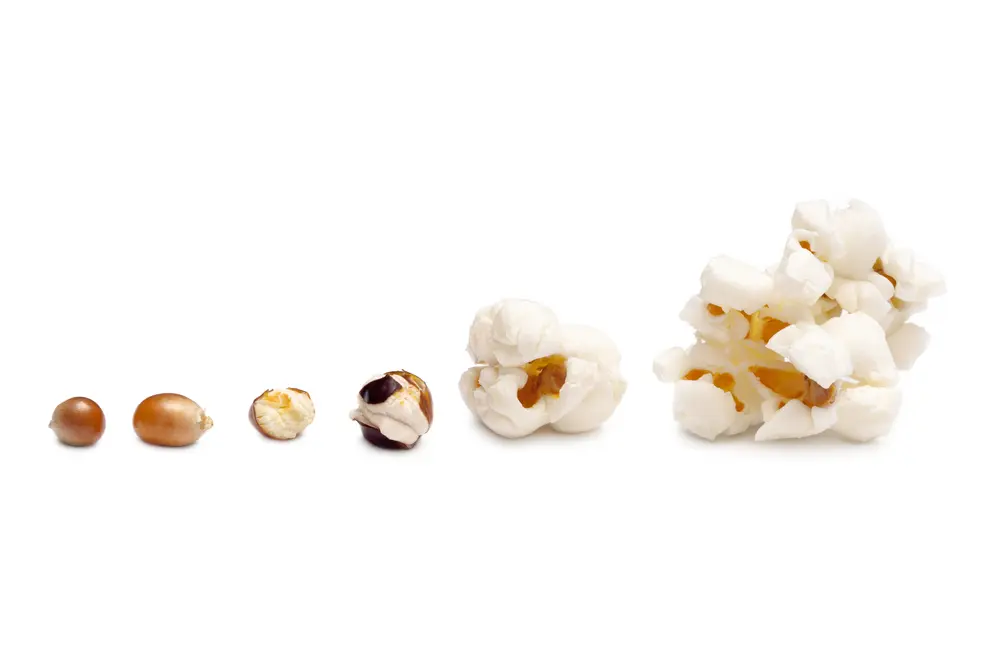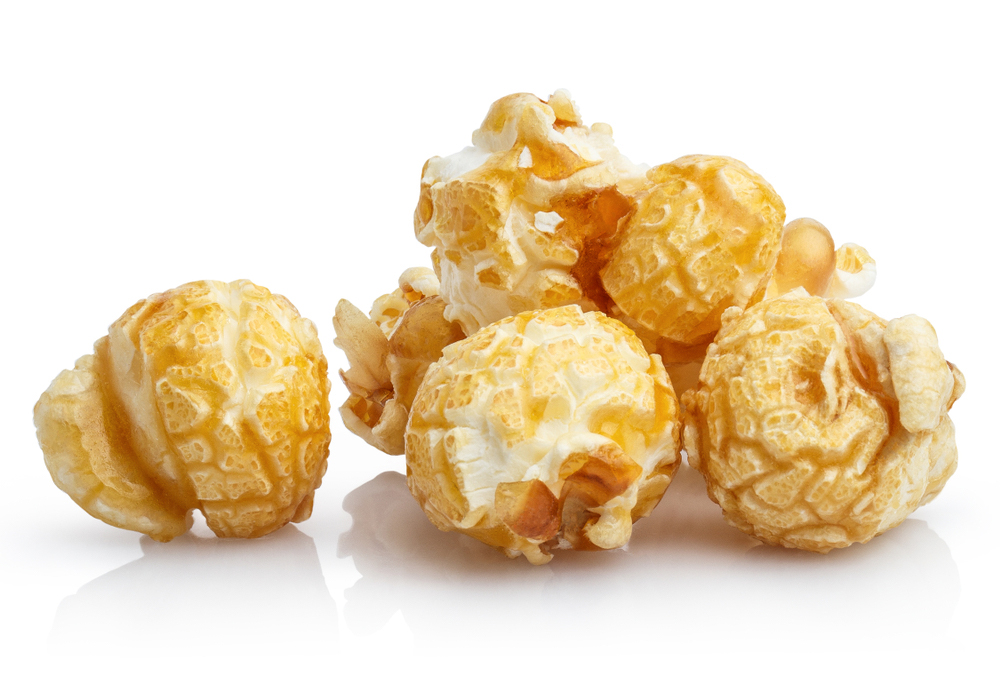Why popcorn pops
Although nearly every one has popped corn at home in a pot the average person knows very little about the why popcorn pops and what affects the process.
Unlike most commercial snack foods the puffing process occurs naturally in popcorn. The popcorn kernel has a very hard hull or pericarp that is capable of withstanding an internal pressure of 135 PSI (9.1 atmospheres). The starch in a popcorn kernel is a hard starch containing about 14% moisture. When a kernel of popcorn is heated the pressure and temperature in the kernel rise, the starch cooks or gelatinizes. At about 135 PSI (9.1 atmospheres), the pericarp ruptures and the pressure is released, the water expands to steam and stretches the starch cells to many times their original volume. The stretched starch cells take on a foam structure. As the steam is vented to the atmosphere, the pressure drops to atmospheric pressure. As the pressure drops the temperature also drops. At the lower temperature the starch returns to a solid state but is now in the form of an open-cell foam. This foam structure is what makes popped popcorn crispy.
The actual popping process requires a delicate balance of heat rate and moisture content. If the kernel is heated too quickly the starch at the center of the kernel is not gelatinized and softened. The starch at the outer edge reaches the required temperature and causes the pericarp to rupture but the uncooked starch at the center of the kernel does not expand. The result is a small hard partially popped kernel of corn. If the heat process is too slow the build up of internal pressure cannot keep up with loss of moisture as steam vents from the tip of the kernel. (The pericarp of the kernel is hard and not porous and contains the increasing pressure. The tip of the kernel where it grew from the cob is not pressure tight and will gradually equalize internal pressure with its surroundings).
The balance that must be made is to heat the kernel at a rate that is slow enough to cook the starch to its core. This must be accomplished before internal pressure ruptures the pericarp: but not so slowly that the small amount of moisture available leaks out before the kernel reaches popping temperature and pressure.
Popcorn Expansion
When a kernel of corn pops there are two primary factors that you should be in interested in. The first is the expansion of the kernel, or how big it pops. The second is the percentage of kernels that do pop.
Expansion is the amount of growth in volume that the corn goes through in the popping process. In general the more the corn expands the better the product. High expansion corn is desirable for both the consumer and the manufacturer.

From a consumer’s point of view high expansion corn is more tender and has fewer partially popped kernels that are hard to chew.
From a commercial standpoint the expansion can have a direct affect on the profitability of the operation. In concession stands at sporting events and in movie theaters the concession operator buys popcorn by weight and sells it by volume (full box or bag). High expansion translates directly to increased profitability. Each percentage point of increased expansion is a reduction in raw material cost.
In snack food plants where the end product is packaged and sold by weight the financial reason to favor high expansion is not as pronounced, however it does exist. The customer usually equates high expansion corn with high quality. For the manufacturer high expansion will create a physically larger bag for the same weight and may be considered a better value by the customer. High expansion corn also usually indicates a low percentage of un-popped kernels or scrap. In this case corn is not only purchased by weight but it is also sold by weight. Lower scrap reduces raw material costs.
If the expansion of the corn supplied to a snack food manufacturer is not consistent it creates two problems. The first is that when customers do not find a consistent product they do not search for a particular brand. The second is that when the expansion is low, a pre-printed bag filled to the correct weight will not appear full to the consumer.
To measure popcorn expansion, commercial corn processors and large popcorn consumers use the Metric Weight Volume Tester (MWVT) to determine the potential expansion of a batch of popcorn. The MWVT is the official measuring instrument of the Popcorn Institute, an organization that represents many of the popcorn processors in the United States. (The MWVT is manufactured by C. Cretors & Co. of Wood Dale, Illinois)
The MWVT was originally developed for the popcorn processors own use in their corn processing plants. Before hybrid grains became common, moisture and growing conditions were the primary factors affecting the expansion of the popcorn. The popcorn processor would take a small sample from a large bin of freshly harvested corn and test it with the MWVT and record the result. The processor would then begin to dry small samples of the corn, testing the expansion as the process continued. As the corn was dried from normal harvesting moisture the expansion would increase. When the tests indicated the expansion was beginning to decrease the processor knew at what moisture content the whole batch of corn should be dried to in order to get the maximum expansion from the corn.
The MWVT consists of a batch type oil popper with a calibrated cylinder into which the popped corn falls. This cylinder is calibrated to define the expansion of the corn in cubic centimeters of popped corn per gram of raw popcorn input.
The MWVT is equipped with instrumentation that permits accurate means of measuring the temperature and energy consumption of the popper and the expansion of the popped corn. This instrumentation makes it possible to duplicate results from one machine to another and provides a means of comparing different batches and hybrids of corn.
In the typical snack food plant a quick method for determining the effectiveness of the adjustments made to the popcorn machine and the efficiency of operation is needed.
The MWVT is used primarily as a guide to the future performance of popcorn when it is popped. Once corn is popped another method of measurement is needed. The most useful is bulk density. While the MWVT defined to volume of popcorn produced as a function of the amount of raw corn that was popped the bulk density of the final product gives an indication of the effectiveness of the popping process itself.
In addition to moisture content, corn hybrid and physical condition also affect the expansion of popcorn. Cracks and abrasion on the outside of the kernels will reduce popping expansion.

